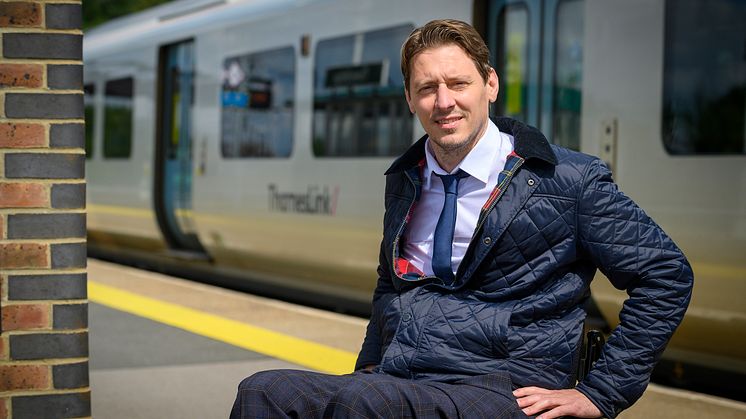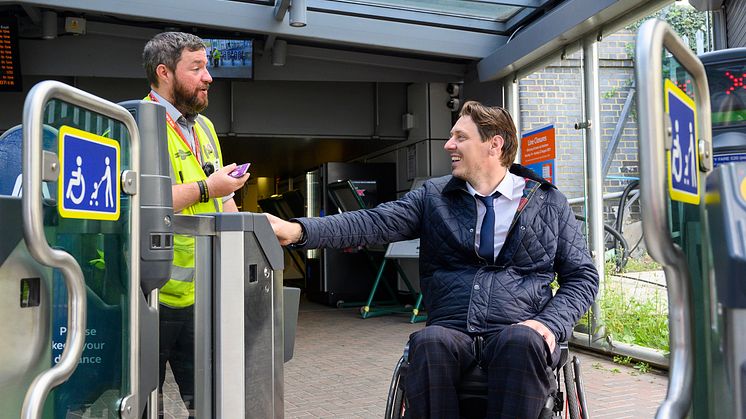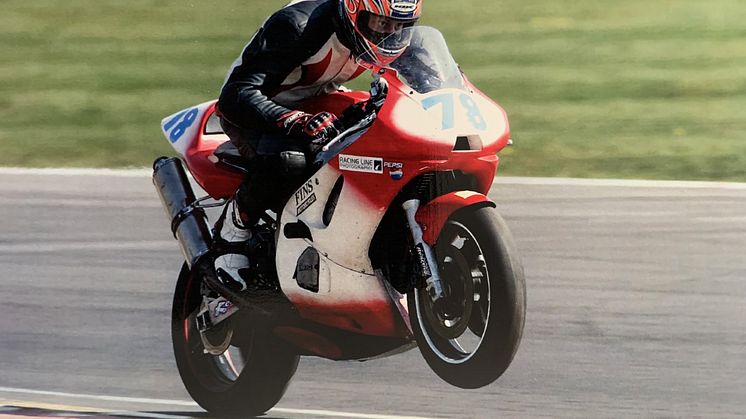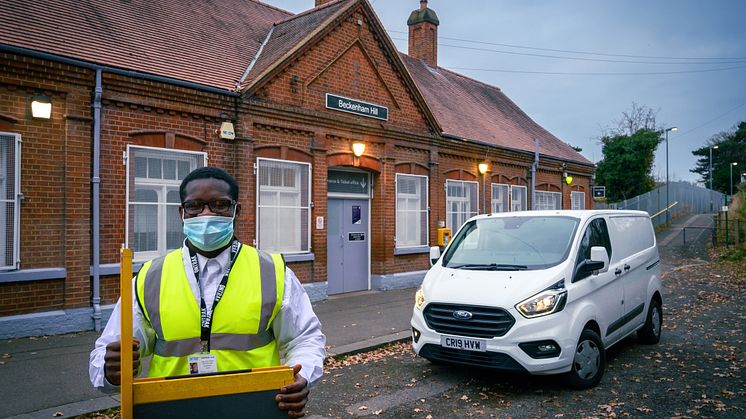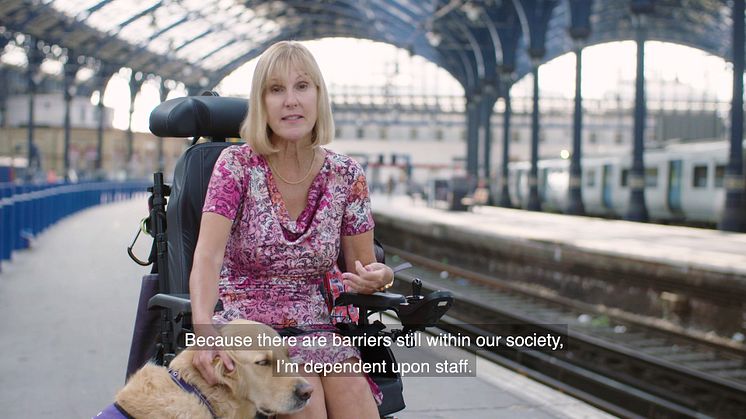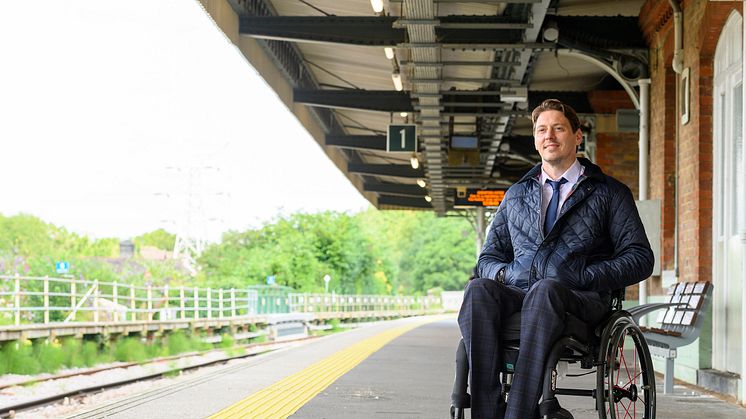
Press release -
Crash survivor Carl calls on more people who need assistance to use the railway
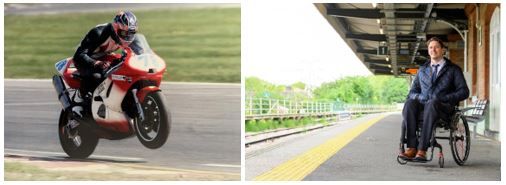
Great Northern, Southern, Thameslink and Gatwick Express, has appointed a new Accessibility Lead, wheelchair user Carl Martin.
Recently disabled, Carl believes “access to transport is access to life”. In recent years, the industry has been on a journey of improvement to ensure the railway becomes more accessible, ensuring that as many barriers as possible are removed and everyone can travel more independently. Carl’s determined to encourage more people to use the assistance and support the railway has to offer.
Carl, 41, from Three Bridges in Sussex, was a surveyor when he lost the use of his legs in a motorcycle racing crash five years ago (view his story in the editor’s notes).
Now, he is spearheading a campaign to highlight the assistance already on offer to help remove the obstacles to travelling by rail, encouraging more people to travel by train more independently and with confidence.
Carl said: “Lying in my hospital bed, I was thinking, how can I turn what has happened to me into something positive? – and that's what I’ve done.
“This is the type of job I always dreamed of – where you come to work to make a positive impact to improve the lives of thousands of people. Now I have this impairment and use a wheelchair, I encounter all sorts of barriers in society that disable me, and I can appreciate the obstacles on the railway.
“We recognise we are on a journey of improvement and the team I now work with has done so much to make things better. With one in five people having some form of disability, I want to build on that to help people gain independence through our rail service by highlighting the assistance we have available to remove those obstacles.”
Govia Thameslink Railway, which runs Great Northern, Southern, Thameslink and Gatwick Express, recognises that it has a mission to improve the level of service it gives people who need assistance to overcome the barriers that prevent independent travel on the railway.
People who can make use of the service include older members of society who may find it harder to negotiate stations and trains and others with non-visible disabilities, such as autism and learning difficulties.
GTR already has systems and processes in place such as staff who will give support and assistance at stations and deploy ramps on to the train, the ability to pre-book assistance if desired with a dedicated 24-hour freephone helpline, priority seat cards and better information to enable passengers to plan their journeys.
GTR’s ‘journey of improvement’ initiatives build on this and were announced as part of a new accessible travel pledge in March. They have been embraced by the entire business and include:
- New accessibility training – GTR has retrained all 3,000 customer-facing colleagues in disability equality courses, delivered by experts who are disabled themselves and use trains frequently. Sessions explored the barriers customers face, how to offer assistance and how to communicate effectively. This gave station and train customer service staff a unique insight into the challenges disabled customers face. New staff at all levels throughout the company are now receiving the same learning.
- Less time needed to book assistance – Passengers are always welcome to turn up at a station unannounced but, for added confidence, the notice they’re asked to give to pre-book assistance, has been reduced from the day before (by 10pm), to six hours before travel. In April 2022 this will reduce to two hours before travel.
- Additional Try A Train days – organised events to give people with learning difficulties the experience and confidence of buying tickets and catching trains
- Better ‘Turn Up & Go’ service for 41 smaller stations – New mobile support teams will be trialled soon to reach 41 unstaffed or partly-staffed stations across the GTR network within 20 minutes to give assistance to passengers.
- New passenger assistance app – new National Rail app allows quick and easy requests assistance via smartphone without needing to contact a contact centre via phone or email
- Enhanced information – Better detailed information about the accessibility of every GTR station on National Rail Enquiries and the websites of Great Northern, Southern, Thameslink and Gatwick Express.
- Website improvements – GTR has also made more than 80 improvements on the Great Northern, Southern, Thameslink and Gatwick Express websites to make them easier for blind or visually impaired people to access and read.
Before joining GTR, Carl worked for the Spinal Injuries Association which inspired him through its work helping him rehabilitate after his accident.
SIA CEO Nik Hartley OBE said: “Carl was part of a national team of dedicated spinal cord injured colleagues whose singular purpose at SIA is to support newly-injured people to rebuild their lives and find their way to a new but equally fulfilled life. But disability is societal, and depends on accessibility at every stage. And so Carl’s decision to work with GTR will be transformative for his peers long into the future.”
GTR shapes its accessibility strategy by listening to the views of its Access Advisory Panel, which is made up of disabled passengers who frequently travel with GTR and has been in place since 2015. Additionally, Accessibility Ambassadors champion excellent passenger assistance among colleagues across the network (see editor’s notes.)
Ends
Notes to editors
Carl’s story
Carl was 36 and working as a Field Services Engineer/surveyor for a well-known national company when his life changed irrevocably. A former motorbike competitor, he’d long hung up his racing leathers and abandoned his teenage dreams of being the next Valentino Rossi.
But racing was still in his blood which is why he took part in a track day at Brands Hatch.
“I wanted to show the young whipper-snappers on the track how to do it. I was coming down Paddock Hill at 115 mph when the back end came out and catapulted me 10ft in the air. I cartwheeled over and over into the gravel, known in the racing world as a Kitty litter handstand.
“I knew straightaway I’d broken my back and damaged my spinal cord because I couldn’t feel my legs. But I’d also broken my neck and I’m so lucky I didn’t damage the spinal cord in that area, as that would have affected the function of my arms as well. With other multiple injuries my life was in danger.
“My daughter at the time was 2½ and all I was thinking was ‘I must live through this.’
“The Spinal Injuries Association came to see me in hospital and the information and support they gave me made such a difference.
“I knew I couldn’t return to a physical job, so from early on I decided to focus on the positives of what I could do and how to use this crossroad in my life to channel my energies on that career change I had longed for. I felt I was extremely lucky and 18 months after injury, bearing in mind 12 months of that was spent in hospital, I was working for the Spinal Injuries Association. I worked as the support network officer for the southeast and was then co-ordinator. It was great to be able to pay back and support people with healthcare and benefits.
“But this was limited to people with injuries like my own. In this job at GTR I’m going to make a difference to people who need assistance for every reason under the sun. This is a great time to be travelling on the railway.”
Ends
1. GTR has an Access Advisory Panel which provides support and guidance in providing a network where everyone has the confidence to travel. The panel consists of volunteer passengers who share their travel experiences and give constructive feedback. The panel was brought together to represent the needs of all of our passengers, including:
- Passengers with visual/hearing impairments
- Passengers travelling with young children
- Elderly passengers requiring assistance when travelling
- Passengers with hidden disabilities
- Passengers with physical disabilities
This important panel meets every two months to share their views and put practical ideas for improvements before senior managers. Their recommendations help GTR to continue to enhance accessibility on its trains and at stations.
2. In 2011, nearly 1 in 5 people (17.9%) in England and Wales reported a disability that limited their daily activities according to ONS data https://www.ons.gov.uk/peoplepopulationandcommunity/healthandsocialcare/disability/articles/nearlyoneinfivepeoplehadsomeformofdisabilityinenglandandwales/2015-07-13
Topics
Categories
For more information, contact the press office on 0203 750 2031.
Govia Thameslink Railway
Govia Thameslink Railway (GTR) operates Thameslink, Great Northern, Southern and Gatwick Express services as follows:
- Thameslink – cross-London services between Bedford/Peterborough/Cambridge and Brighton/Horsham/Littlehampton/East Grinstead, and between Luton/St Albans and Sutton/Wimbledon/Rainham; plus services between London and Sevenoaks
- Great Northern – services between London and Welwyn, Hertford, Peterborough, Cambridge and King’s Lynn
- Southern – services between London and the Sussex coast (Brighton, Worthing, Eastbourne, Bognor Regis, Hastings) and parts of Surrey, Kent and Hampshire (Ashford International, Southampton, Portsmouth)
- Gatwick Express – fast, non-stop direct services between Gatwick Airport and London Victoria (currently suspended during the pandemic)
www.southernrailway.com, www.thameslinkrailway.com, www.gatwickexpress.com, www.greatnorthernrail.com

